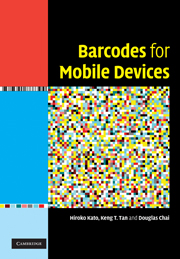Book contents
- Frontmatter
- Contents
- Preface
- 1 Introduction
- 2 Barcode technology evolution
- 3 Two-dimensional barcode for mobile phones
- 4 Evolution of barcode applications
- 5 Technologies for enhancing barcode robustness
- 6 A prototype colour 2D barcode development
- 7 Evaluation of the prototype colour 2D barcode
- Appendices
- References
- Index
- Plate section
3 - Two-dimensional barcode for mobile phones
Published online by Cambridge University Press: 06 July 2010
- Frontmatter
- Contents
- Preface
- 1 Introduction
- 2 Barcode technology evolution
- 3 Two-dimensional barcode for mobile phones
- 4 Evolution of barcode applications
- 5 Technologies for enhancing barcode robustness
- 6 A prototype colour 2D barcode development
- 7 Evaluation of the prototype colour 2D barcode
- Appendices
- References
- Index
- Plate section
Summary
Since their first appearance, 2D barcodes have evolved with additional features including security, error detection and correction capability and the ability to encode different languages. The ability to encode a robust portable data file has made 2D symbologies attractive regardless of their extra space requirements. Accordingly, industries and organisations in various fields have adopted applications that use 2D barcodes within their systems. These range from medicine labelling for the healthcare industry and the marking of small items such as integrated circuit boards for IT vendors through to the secure transmission of battle-field plans in the defence industry. However, despite its potential for wider use, this technology has been adopted by only a few industries and organisations.
Mobile devices such as mobile phones and personal digital assistants (PDAs) are another notable technology that has evolved during the last decade. With their current sophisticated functions these devices can provide an entertainment centre, performing the role of a game console, a jukebox, a digital camera and a social organiser. As more advanced features and applications are developed, they should become less expensive and more commonly used. In fact, PDAs and mobile phones are now virtually universally used in industrialised countries across different age groups. Furthermore, they are always available, providing seamless and ubiquitous connectivity. As the research firm Gartner has predicted [19], this trend is expected to continue for some years.
Two-dimensional barcodes and mobile phones have a lot in common. They have become smaller, yet smarter, in the last decade and are still being improved.
- Type
- Chapter
- Information
- Barcodes for Mobile Devices , pp. 49 - 93Publisher: Cambridge University PressPrint publication year: 2010



